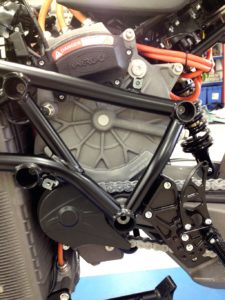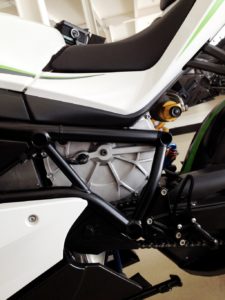CRP introduces Windform P-LINE range for HSS 3D printing
CRP Technology makes Windform unavailable to 3D printing service bureaus
Energica establishes new department for development of Energica Ego motorcycle
3D Printing Combines with Other Technologies for Latest Energica Ego Component
 Following the progress of the CRP Group and its subsidiary Energica over the past few years has been exciting, as the companies work together to develop 3D printed electric superbikes such as the Eva, Ego, and Ego Corsa. The Ego made its public debut at CES at the beginning of 2016, and has wowed the public not only with its performance but with the advanced manufacturing that went into its creation: 3D printing, using Selective Laser Sintering and CRP’s Windform family of materials, and CNC machining.
Following the progress of the CRP Group and its subsidiary Energica over the past few years has been exciting, as the companies work together to develop 3D printed electric superbikes such as the Eva, Ego, and Ego Corsa. The Ego made its public debut at CES at the beginning of 2016, and has wowed the public not only with its performance but with the advanced manufacturing that went into its creation: 3D printing, using Selective Laser Sintering and CRP’s Windform family of materials, and CNC machining.
The Energica Ego continues to undergo development, and recently Energica engineers along with CRP staff worked together to focus on the motor housing, a complex, important component of electric motorcycles. From the beginning, the team worked to redesign the part in order to accommodate the rotor, stator, and speed reducer. The propulsion unit to be supported is flexible and compact enough that the Energica motor housing can be adapted to any vehicle, and the reducer is composed of a straight-cut gear train that adds strength along with simplicity of design. The structure holds the shaft and pinion and final drive to the wheel with a standard motorcycle chain.
To redesign the motor housing, the team had several requirements. The electric motor was heavy and needed to be balanced out by a lightweight housing, and because the motor generated high torque it required high resistance. The gears needed to be the correct size, and the materials and heat treatments would need to be carefully chosen.
 The first step was creating a functional prototype, which was done by CRP Technology. It was manufactured using SLS technology and Windform LX 2.0, a composite polyamide-based material reinforced with a new-generation glass fiber now replaced by Windform LX 3.0. The prototype allowed the technicians to validate the 3D CAD drawing and helped Energica mechanics to work on the motorcycle’s development. It was mounted directly on the motorcycle, allowing for a full check of potential issues related to the assembly of each part.
The first step was creating a functional prototype, which was done by CRP Technology. It was manufactured using SLS technology and Windform LX 2.0, a composite polyamide-based material reinforced with a new-generation glass fiber now replaced by Windform LX 3.0. The prototype allowed the technicians to validate the 3D CAD drawing and helped Energica mechanics to work on the motorcycle’s development. It was mounted directly on the motorcycle, allowing for a full check of potential issues related to the assembly of each part.
“Being able to touch the 3D printed prototype of the motor housing was very important for us, as we are the ones who manage fit and assembly,” stated the Energica technicians. “For example, we have been able to study first-hand if the component can be assembled and disassembled easily; if all the parts can be reached; if it is possible to use standard wrenches … We must put ourselves in the shoes of those who will handle the motorcycle on the market: customers, dealers and mechanics of authorized workshops.
“Designing and creating a motorcycle is a team effort between designers, technicians and engineers. We deal with technological/engineering, design, functionality issues; the final aim is to match the work of the three sectors. The prototypes created in Windform 3D printing allow you to study the various elements, and to improve them where required by shortening development time and reducing costs.
“Through the combination of LS technology and Windform composite materials, it is possible to ensure the ongoing study of the components. The prototypes made in Windform are 100% functional, we can mount them on the motorcycle and test them on the road and on the track. We do not waste time which, at this stage, is very precious.”
The next step, after the validation of the CAD file, involved the creation of an aluminum prototype. The requirements included performance, light weight, and resistance to temperature. Using aluminum alloys 6082 and 7075, CRP Meccanica CNC machined the part with its 5-axis production systems. The central part, which was the largest, originally had a pass-through window to allow the motor to be positioned inside. Each side was a half shell, and one of the two halves held the gearing housing, sealed in with a cover. The other half housed the pinion and oil pan.
“This phase has been completed in a short time,” the technicians stated. “CRP supported us very much, and we did not have any problem with the component, both during the bench tests and the assembly on the motorcycle: the tolerances required were very complicated and tight, as the project included two rows of bearings (those on the motor, plus the outer ones to support the output shaft). Later, we were able to validate the road-going prototype.”
The next phase involved the realization of models for pre-series. The component was manufactured using traditional sand casting, with the same alloy used in the metal prototyping phase. The production of the part was truly a team effort – between Energica and CRP, and between three different technologies that worked together to produce a strong, lightweight and high-performing component.
Discuss this and other 3D printing topics at 3DPrintBoard.com or share your thoughts below.
[Images: CRP Group]


